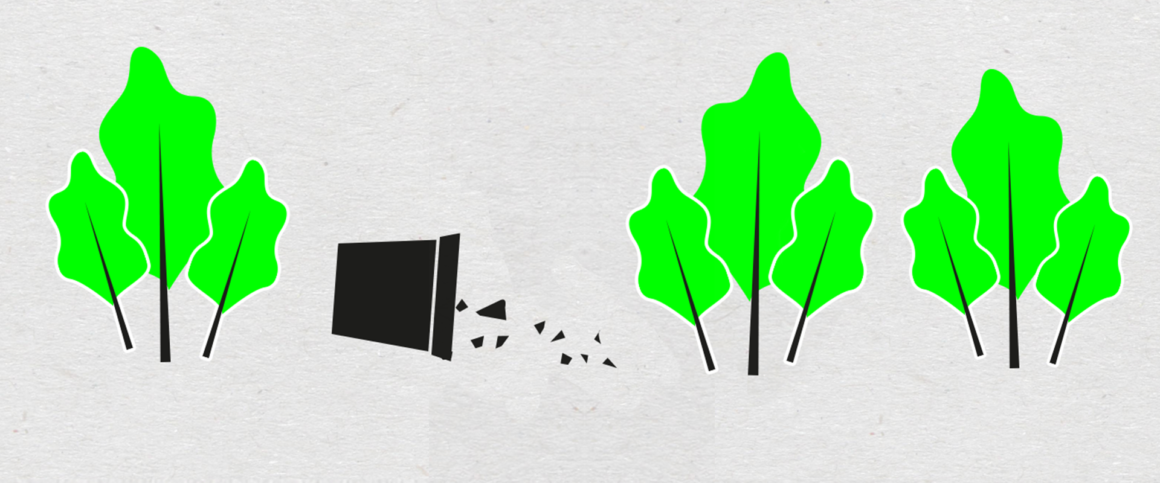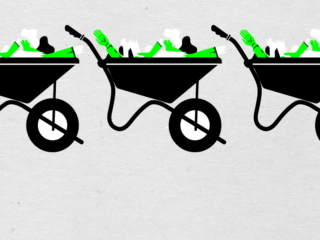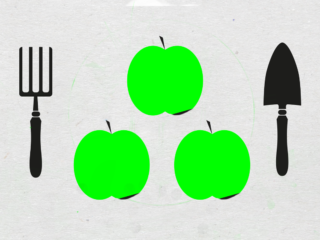From leaf mould to pee, here’s our three favourite don’t-buy-it, make-it gardening hacks

We’ll say this for lockdown: it stopped everyone going to the garden centre. Not that we have a particular problem with garden centres, even though the racks of scented candles and Peter Rabbit table mats make us feel faintly tired. It’s just that making constant trips out to buy bagged compost or packets of fertiliser goes against the zombie-gardening mantra of reducing reliance on off-site resources. So we kind of welcomed not being able to nip down to B&Q/Homebase/Petals for Plants, and instead having to get creative and find some home-made alternatives to shop-bought garden staples. There were three hacks in particular that worked well for us – so well, in fact, that even now stores are open again, we won’t be going back any time soon. Here, in the hope you might find them equally useful, is what they were.
Leaf it out
As a rule, we don’t buy many bags of compost. We improve our soil with the contents of our compost heaps, plus well-rotted manure from a local sheep farmer (a quid pro quo for letting him graze sheep on our fields each autumn). For pricking out and potting on, we make our own mix of sieved garden compost, coir, and some of the lovely, stone-free topsoil thrown up in mounds by the mole family that lives in, and regularly destroys, our back garden. But what we do usually buy is one or two large bags of sterile, fine-grade and of course peat-free seed compost: mixed 1:1 with coir this is enough for a year’s worth of sowing.
Not this year, though. When sowing season started in February, we had a bit of seed compost left over from last year. But then lockdown started, everyone went gardening-nuts, and there was no more compost to be had online or off. Which was when we turned to leaf mould.
If you’ve never made leaf mould, it’s the simplest thing. In autumn, once the trees start their annual drop, just gather up all the fallen leaves you can find, stuff them into some kind of container (we use builder’s bulk bags, because the handles mean they’re easy to move around), then chuck them in an out-of-the-way corner. After a couple of winters your containers will be filled with light, open-textured rottiness, brilliant for mulching, earthing up potatoes and just generally adding useful organic matter (OM) to your soil.
Leaf mould may be rich in OM, but what it doesn’t have is many plant nutrients. Counter-intuitively, that makes it a good medium for germinating seeds – because too high a level of, say, nitrates in soil stops seeds absorbing water by osmosis, the first step to successful germination. And though leaf mould in its natural state is pretty coarse – ours is full of twigs, stalks, bits of gravel and some pretty creepy white worms – we found that, as long as we sieved it through a medium mesh garden sieve, it worked incredibly well as an alternative to shop-bought seed compost.
That went for all sizes of seeds: from big boys like pumpkin, to pepper-corn sized brassica seeds, right down to the very fine, blink-and-we’ll-blow away kinds like lettuce and celeriac. For these real tinies, we took a bit of extra care tamping the surface of the leaf mould first, so that seeds didn’t fall into air pockets and dry out; then we got out our fine-mesh sieve and used that to cover the seeds with a very light dusting of, yes, more leaf mould.
When it came to pricking-out time, we turned to our leaf mould again, this time using it as a moisture-retaining, texture-improving substitute for coir, and mixing it 1:1:1 with molehill topsoil and sieved garden compost. All the seedlings romped – apart from our first batch of tomatoes, which went twisty. Though we suspect that was nothing to do with the growing mix, but instead was their reaction to the extremes of hot and cold this year’s mad March threw at us.
So far, we’ve only come across two mouldy downsides. First, sieving is quite hard work – there’s a lot of side-to-side shaking involved – and it takes time. Not as much time, though, as driving to a garden centre and back; also driving doesn’t give you toned upper arms. Second, because leaf mould isn’t sterilised like bagged seed compost, you get a lot of weed seeds germinating alongside your babies. As a rule, though, we found that most veg varieties germinated quicker than the weeds, which meant we could, uh, weed out the unwanted visitors when they did arrive. And as long as you sow carefully – bang in the centre of modules, or in neat(ish) rows in seed trays – it’s easy to tell friend from foe. Anyway, we noticed that weeds that came up after pricking out prevented our usual problem of liverworts growing on the surface of the pots; and, surprisingly, they didn’t seem to have a negative affect on root development. Perhaps their presence spurred the veg seedlings on? Whatever, leaf mould is our new favourite ingredient, and bagged seed compost can stay on the garden centre shelves. Next to the Peter Rabbit table mats.
Pees on earth
So, that was our sowing problem sorted. Next up: nitrogen deficiency. Last winter was extraordinarily wet – where our zombie garden is, in the south-east corner of the UK, it started raining in mid-October, and didn’t stop until the end of February. The continuous heavy rain meant that soluble forms of nitrogen in the soil got washed away, and come spring there was hardly any available for plants starting into growth. That, and an epidemic of root rot from the wet winter, meant serious trouble. Raspberry canes pushed out a few spindly yellow leaves that then crisped and died. Apple-tree and rose leaves unfolded with sickly pink and white edges, new kale leaves were small and yellow instead of vigorous and green.
Adding well-rotted manure or generous helpings of garden compost would have helped return nitrogen to this poor, exhausted soil – but not quickly. To get our plants back into gear and ready for cropping we needed a fast-acting nitrogen fertiliser. In a pre-Covid, non-apocalypse world we could have nipped out for a packet of sulphate of ammonia, or a bottle of Miracle-Gro. But now, there was only one place we could go. The toilet.
Human urine, as readers of our book will know, breaks down in soil to release ammonium salts, a form of nitrogen that is immediately accessible to plants. According to Martin Crawford – the forest-gardening expert at whose sandalled feet we worship – each square metre of standard veg patch will use up 28g of nitrogen a year, while the average adult pees out around 11g of nitrogen a day. So to keep a standard allotment of 80 square metres up to full nitrogen-speed, you need the equivalent of 203 days’ worth of pee. All of which makes flushing seems like a terrible waste of waste
Which is why we wrote “Pee Bucket” in permanent marker on a watering can, left it in the downstairs loo, and every morning diluted the contents 1:10 with water before pouring it on the soil at the base of whichever plant seemed neediest. Four months on, and everything from a young mulberry tree to an elderly rhubarb has responded with glee, leafing out in full glorious green. About the only thing pee didn’t help were the sickliest of the raspberry canes, which continued on their path to death – though new canes have come up next to them looking fine and healthy. Pee Bucket is now our total go-to for a quick nitrogen fix. Though once we start having visitors come round again, it might have to move back to the potting shed.
K-Pops
Our final problem was potassium. Whenever you see a nitrogen or N-deficiency start, odds are a potassium deficiency will follow. It’s not quite as prone as N to washing away in heavy rain, but K (the chemical symbol for potassium) is key to good flower and fruit formation, and a zombie garden like ours, with lots of fruiting crops like apples, tomatoes, squash and strawberries, needs a regular K top-up.
The shop-bought way of doing this is to use a high-K fertilizer like liquid tomato feed, or a packet of sulphate of potash. That was obviously off the agenda in lockdown, although to be honest when it comes to K we don’t buy in much anyway: we have a wood-burning stove that over the course of a winter creates loads of potassium-rich wood ash. A light dressing of this around the base of fruit trees and bushes in mid-February is usually all our garden needs. This year though, the monsoon-like winter meant that by April many of our plants were showing signs of potassium deficiency: yellowing leaves with scorched brown tips on the autumn onions, bay tree and strawberries, purpling and scorching on the blackberry leaves. Because of the potential for lockdown-related food shortages, we had also planned to double our tomato planting, which meant we’d need some kind of liquid K-fertiliser once the tomatoes started forming their first flowers.
Now we know what some of you are thinking: comfrey tea. Chopping up comfrey leaves and letting them rot down in a bucket of water is the standard organic-gardening way to create a (very stinky) liquid K-feed, and it works. But our comfrey patches don’t get big enough to handle a leaf cut until around May, and we needed to help our plants before then. So instead we used nettles.
Nettle tea is an old gardening remedy that gets rather ignored these days. That’s a shame. You make it exactly the same way as comfrey tea, and it works just as well – because its leaves contains almost the same concentration of potassium as Russian comfrey (the kind organic gardeners grow)1. And while if you want a controllable comfrey patch you’ll most likely have to grow plants from Bocking-14 root cuttings, nettles just kind of – turn up. Even if there’s none in your garden, they’re hardly tricky to find. And yes, they sting, but comfrey leaves are almost as unpleasant to handle: they’re covered in fine, irritating hairs, making gloves pretty much essential. Nettle tea, kindly provided by the huge and frightening nettle patch down by the pond, got our sickly bay tree, blackberries and autumn onions back on track; and by the time the tomatoes were feeling hungry the comfrey was ready to step in.
So there they are, our three don’t-go-to-the-garden-centre heroes. All easy to find, low/no-carbon and completely free. How satisfying is that?

COIR Coir is a rough, brown fibrous material made from coconut waste. Gardeners buy coir in lightweight, compressed blocks which, soaked in water, double up as a good moisture-retaining agent for home-made potting mixes. Other people buy coir carpet, which doubles up as a good way to remove all the skin from the soles of your feet.

1 USDA Agricultural Data Commons, Dr Duke’s Phytochemical and Ethnobotanical Database










